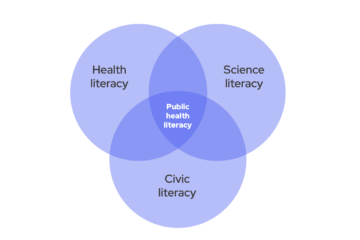
Trying to connect with a child on a complex issue serves as a humble reminder that communication takes practice and patience.
At the annual meeting of the National Association of County and City Health Officials (NACCHO) in July, a panel presented by the de Beaumont Foundation offered insights into perceptions that may limit partnerships between public health and other sectors — and some practical steps to open doors and build understanding.
Moderated by John Dreyzehner, former commissioner of the Tennessee Department of Health, the panel included award-winning journalist Soledad O’Brien, CEO of Starfish Media Group, Nat Kendall-Taylor, PhD, the CEO of the FrameWorks Institute, and Shelia Hiddelson, health commissioner of the Delaware General Health District and a PHRASES Fellow. The bottom line? Public health professionals need to be better at telling their own story and making public health relevant and relatable for people in other fields. That basic understanding is the first step toward trusting relationships that will improve community health. As Dreyzehner framed the problem, “We are passionate, hard-working, and committed people in public health, and we have a really important story to tell. We have a great story, but we don’t tell it very well — kind of like a company with an incredible product, but struggling with sales.”
We have a great story, but we don’t tell it very well — kind of like a company with an incredible product, but struggling with sales.
If people don’t understand what you do, they won’t care about what you do, O’Brien said. And the way public health professionals currently tell their stories — often with data and negative messages about threats and risks — isn’t working. O’Brien reflected on her experiences as a journalist being pitched for stories. She said public health officials are well intentioned when they explain the role they play and recommend policies and other actions to improve health outcomes. She advises people and organizations to “show us, don’t tell us.” Show us the people who are affected, positively or negatively, because ultimate “communities” are people.

She warned public health professionals to avoid their internal jargon when talking to people who are not in public health. “I’ve been asked to give speeches about social determinants of public health,” she said. “I wish people would stop using that phrase — it’s a terrible phrase. When I was asked to give a speech about it, I was like, ‘I’m not really sure what that is, so how can I give a speech about it?’ “But we actually tell stories about it all the time, and when you frame it as social determinants it actually sounds scary or incredibly boring, and complicated. If you talk about the social determinants of health, people will be like, ‘I’m pretty sure I’m not smart enough to even understand what that means.’ ”
In Dr. Kendall-Taylor’s remarks, he said there’s often a major disconnect between public health professionals and leaders in healthcare, business, education, and housing. He cited research the FrameWorks Institute recently conducted for the PHRASES project (Public Health Reaching Across Sectors), led by the de Beaumont Foundation and the Aspen Institute. Through in-depth interviews with sector, he and his team found significant gaps in understanding.
“It’s not that people don’t understand what the words you use,” he said, “but the understanding they have is incredibly narrow. You may think you have a perfect way to talk about your work, but then you find that the message that you thought was so clear, so gripping, so moving, isn’t to the people you are trying to reach. It goes in one ear and out the other.” The words that public health professionals make sense to them, he said, but when they use those same words to people in other fields, the words can mean very different things. It’s easy for words to get lost in translation because of the differences in culture and areas of expertise.
He added, “Your content knowledge matters, but it’s not all that matters. If you are going to use that expertise to have an impact, you have to learn how to say what it is you have to say.”
Your content knowledge matters, but it’s not all that matters. If you are going to use that expertise to have an impact, you have to learn how to say what it is you have to say.
The value in well-framed information lies in the fact that “the way that we communicate, the choices we make as communicators — sometimes small choices like the pronouns we use, ‘us’ or ‘them’ or ‘we,’ and sometime large choices like the values we use — affect the way that people think and feel, and what they’re willing to do. The language choices we make in how we present information have effects on people’s perceptions and behaviors.”

Dreyzehner underscored the importance of the PHRASES initiative. “At the core,” he said, “this is about communicating in a way that fuels our partners’ passions. Learning what’s important to them, what they need, how they need to hear it, and working as humbly as we possibly can to help them get there.”
The de Beaumont Foundation and the Aspen Institute’s Health, Medicine, and Society Program launched PHRASES in 2017 to help public health officials better communicate the impact and value of their field to other sectors. The full research findings, recommendations, and tools will be available soon.




